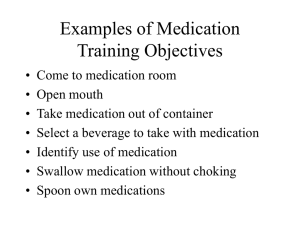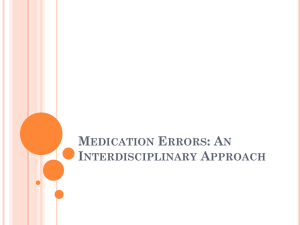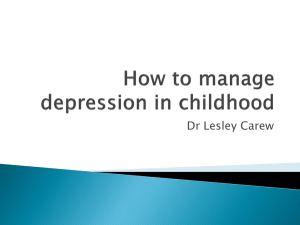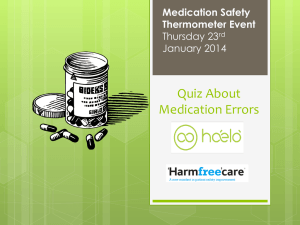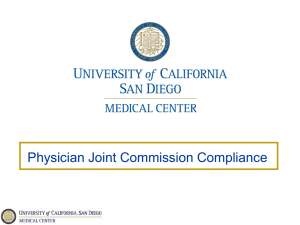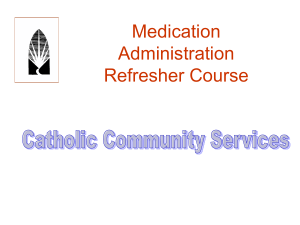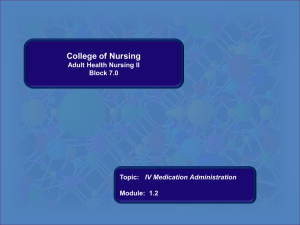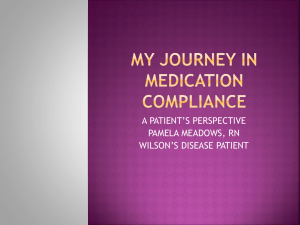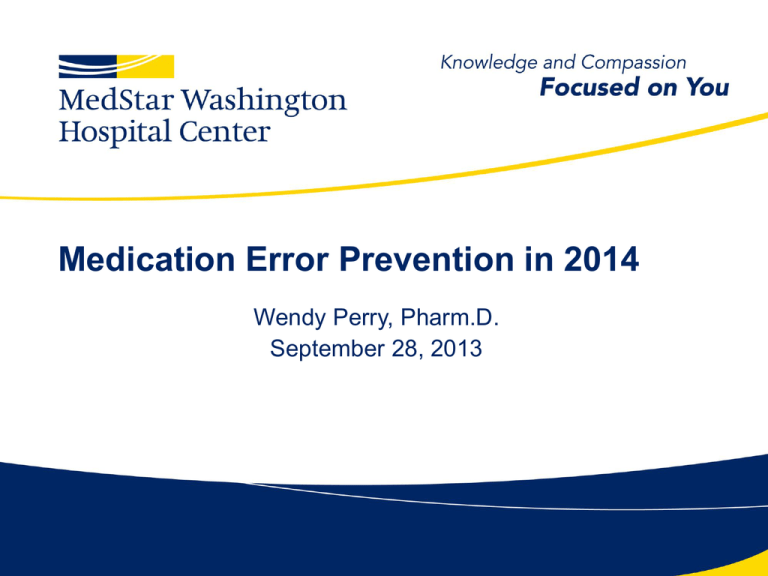
Medication Error Prevention in 2014
Wendy Perry, Pharm.D.
September 28, 2013
Objectives
• Describe a Medication Safety Officer’s
responsibilities.
• List new safety challenges that are a result of
technological advances.
• Discuss the mechanisms for obtaining
medication error data.
• Describe a data analysis process and
appropriate follow up.
• Define “Just Culture.”
• Discuss methods to reduce medication errors.
Why Medication Error Prevention in 2014?
3
4
5
6
Medication Safety Officer
Job Description
– Guide and coordinate the organization’s medication
safety activities
– Analyze data to identify trends and recommend
priorities
– Examine entire medication use system
– Engage key stakeholders
– Knowledge expert on committees
– Present educational sessions
Larson CM, Saine D. Medication Safety Officer’s Handbook. ASHP;2013
7
New Technology
Safety Challenge
Computer Prescriber Order Entry (CPOE)
and
Clinical Decision Support (CDS)
Alert fatigue
Unforeseen challenges
Bar Code Medication Administration
(BCMA)
Workarounds
Missing or incorrect barcodes
Automated Dispensing Cabinets (ADC)
Non-profile areas
Volume of barcodes
Maintenance of alerts
Override lists
Smart IV Pumps
Bypassing drug library
Robotics
System integration
8
Computerized Provider Order Entry (CPOE)
and Clinical Decision Support (CDS)
• Pros
– Decreased number of steps in the medication
process, pre-populated fields, etc. improves safety
– Provision of clinical info related to allergy, dose,
duplicate therapy, etc. improves safety
• Cons
– Complicated screens
– Easier to make incorrect choice in patient, drug
sentence
– Alert fatigue
9
Post – CPOE
1 st PSE received: Wrong Patient
Order for insulin received by pharmacist who was
familiar with patient and recognized not
appropriate
Wrong patient was selected by MD
Prevention methods:
Only one patient MR open at once
Create patient list
10
Bar Code Medication Administration
(BCMA)
• Background
– 34% of all med errors occur in administration
– 50% of hospitals in 2011
– 25% of nursing time spent on med-related activities
• Prospective before and after observational study
– 386 bed academic teaching hospital
– 2 medical-surgical units, 2 ICUs
– Med admin errors assessed by comparing observed med
administered to med intended for that patient
Helmons PJ. Effect of bar-code-assisted medication administration on medication administration errors
and accuracy in multiple patient care areas. Am J Health-Syst Pharm. 2009;66:1202-10.
11
Results
• Error rate = # of errors
total opportunities for error
• Separated wrong time errors from other errors
• Med-surg: overall 8% to 3.5% (p<0.0001)
omissions 4% to 1% (p<0.0001)
ICUs:
NS, charting compliance improved
12
13
Raising the Bar for BCMA: Addressing Pharmacy Challenges, Nursing
Engagement, and Data Analysis to Improve Practice; Beaumont Hospital; ISMP Webinar
2013.
14
BCMA Safety Opportunities
• Scanning omissions
• Bypass alert
• Work-arounds
– Barcode copies
– Wrong time
• Front or back scanning for convenience, patient availability
• To complete documentation
– Wrong reason chosen
15
Automated Dispensing Cabinets (ADC)
• Non-profile units
• Override medications
• Incorrect medication fill – decreased with bar
codes
–
–
–
–
Spill over
LASA medications
Replacement by nurses
Quantity to be scanned
• Alert fatigue
16
Smart IV Pumps
• Override functionality – drug libraries are the
core safety feature
• Alert fatigue
• Lack of interface
17
Tools to Identify Safety Needs
•
•
•
•
•
•
•
•
•
Voluntary reporting data
Trigger tools
Culture surveys
Published literature and reporting sources
Walk around
Pharmacist clinical interventions
Med administration BCMA scan failures
Bypassed alerts and overrides
Failure mode and effects analysis (FMEA)
18
19
Voluntary Reporting
• Reported medication error rates are simply a measure of
the ability of the organization to recognize and report
medication-related problems.
• Therefore, an organization with a large number of error
reports may actually (and in many cases is likely to)
have a lower true underlying medication error rate than
an organization where few reports are received,
analyzed, and acted on.
Larson CM, Saine D. Medication Safety Officer’s Handbook. ASHP;2013
20
Specific Event Type
Mandatory: Yes
Pick List Values (Single-pick)
• Adverse Drug Reaction
• Administration Technique
Incorrect
• Dose Incorrect
• Drug With Known Allergy
• Medication Administered
Not Ordered
• Narcotic Count Incorrect
• Illegible Order
• Time Incorrect/Delayed
• Outdated/Unusable
Medication
•
•
•
•
•
•
•
•
Drug Incorrect
Monitoring Issue
Patient Incorrect
Omission
Route Incorrect
Storage Incorrect
Drug Preparation Issue
Pump Programming
Issue
• Documentation Error
• Other (please specify)
22
Contributing Factors
Mandatory: No
Pick List Values (Multi-pick):
•
•
•
•
•
•
•
•
•
•
•
•
•
Communication/Handoff Failure
Competency of Staff
Lack of Training/Education
Insufficient Staff
Action by Family
Member/Caregiver
Action by Patient
Policy/Procedure Issue
Physical Environment
Condition/Design
Insufficient Monitoring/Supervision
Work Environment-Fatigue
Language Barrier
Administration Issue/Calculation
Error
Drug Name Confusion(e.g. Look
Alike & Sound Alike)
•
•
•
•
•
•
•
•
•
•
•
•
•
Medication Not Available
Distractions/Interruptions
Monitoring – Vital Signs Not
Checked
Patient Unavailable
Incomplete/Ambiguous Order
Preparation – Delayed Delivery
Preparation – Wrong
Drug/Dose/Strength
Transcription Issue – Incorrect
Computer Order Entry
Transcription – Order Not Entered
In Computer System
Drug Info Missing – Inadequate
Medication Reconciliation Process
Patient Info Missing – Allergies
Patient Info Missing – Lab Values
Patient Info Missing – Weight
Other (please specify)
23
ADR vs ADE
• Medication Error
A preventable error occurring in any step of the
medication process
• Adverse Drug Event
An undesirable occurrence associated with a
medication
• Adverse Drug Reaction
An idiosyncratic reaction or other adverse effect of a
medication that is not preventable
24
Med
Errors
ADE
ADR
Near
Miss
25
Interpretation
• Near Misses are Med Errors
– Caught by chance
– Caught by following a safety process
• ADRs are not Med Errors
– All ADRs are ADEs
– Not all ADEs are ADRs
– Focus and follow up is different
• Involves patient management
• Future prevention and education
• Reporting if necessary
26
C, D
Med
Errors
ADE
E-I
ADR
Near
Miss
B
28
Purpose of Nomenclature and Definitions
• Communication within institutions and
corporations
• Regulatory self-assessment
• Trending and consolidation
• Monitoring performance
• Benchmarking
29
Don’t get overwhelmed with data
collection and/or analysis
The most important aspect of medication safety is
to apply what has been learned to implement
changes in the organization to decrease the
potential for harm to patients.
30
How to Set Priorities
• National Coordinating Council on Medication
Error Reporting and Prevention (NCC MERP) –
Categories A – I
• Causes of a level where harm occurred often
also seen in near misses
31
Data Analysis
• Departmental
Event Type: Pump Programming
Contributing Factor: Hand-off Failure
Severity: E-I
Medication: Insulin
Location: 5NE
• Interdisciplinary Committee
Medication Management: Nursing and Pharmacy, monthly
• Hospital Committee E-I
Patient Safety Event Review: Multidisciplinary, biweekly
• Quality Department
Root Cause Analysis (RCA)
32
Tools from Highly Reliable Industries
1. Failure Mode and Effects Analysis (FMEA)
FMEA is an ongoing quality improvement process that is carried
out in healthcare organizations by a multidisciplinary team. It can
be employed to examine the use of new products and the design
of new services and processes to determine points of potential
failure and what their effect would be – before any error actually
happens. FMEA is a proactive process used to look more
carefully and systematically at vulnerable areas or processes. In
this regard, FMEA differs from Root Cause Analysis (RCA).
33
2. Root Cause Analysis (RCA)
Usually RCA is a reactive process, employed after an
error occurs, to identify its underlying causes.
Required by The Joint Commission for sentinel events,
defined as “an unexpected occurrence involving
death or serious physical or psychological injury, or
the risk thereof.”
Includes an action plan, and monitoring the
effectiveness of the plan.
34
Just Culture
Whack-a-Mole by David Marx, J.D. 2009
This book argues that our Whack-a-Mole approach
to inevitable and often predictable human error
is ineffective, inefficient, and unjust; it does
nothing to enable us to learn what we might do
differently next time, or what systems we might
put in place to minimize the chances of causing
the same adverse outcome again.
35
Just Culture
We spend far too much time looking at the severity
of the adverse outcome (how bad was it?) and
who was the unfortunate soul to be closest to
the harm. In turn, we spend far too little time
addressing the system design that got us there
and the behavioral choices of the humans in
those systems that might have ultimately
contributed to the adverse outcome.
36
Just Culture
The Behaviors We Can Expect:
• Human error -inadvertent action; inadvertently doing
other that what should have been done; slip, lapse,
mistake.
• At-risk behavior –behavioral choice that increases
risk where risk is not recognized or is mistakenly
believed to be justified.
• Reckless behavior -behavioral choice to consciously
disregard a substantial and unjustifiable risk.
37
Just Culture
•
•
•
•
Console the human error.
Coach the at-risk behavior.
Punish the reckless behavior.
Independent of the outcome.
38
It’s About Changing Staff Expectations
(from Just Culture literature)
•
•
•
•
Looking for the risks around me
Reporting errors and hazards
Helping to design safe systems
Making safe choices
–Following procedure
–Making choices that align with
organizational values
–Never signing for something that was
not done
39
Error Prevention Strategies
• Improve communication and handoff
• Situation, Background, Assessment, Recommendation
(SBAR)
• Handoff Checklist
•
•
•
•
•
Catch phrases
Multidisciplinary or team safety meetings
Technology
Catch of the Month
Double Checks
40
Double Check
The virtues of independent double checks –
they really are worth your time!
ISMP December 17, 2009
The average “checking error rate” (errors
missed during a double-check) is about 5%.
In studies where “artificial errors” were
introduced into medication carts and sample
pharmacy orders, 93% to 97% of such mistakes
were identified during an independent doublecheck.
41
Double-checks work best when they are
conducted independently.
• The person checking has to form an independent judgment without
cues from the person doing the initial work (why ISMP encourages
“independent double-checks”).
•
It would be more effective, for example, to have two people
calculate a dose separately and then compare their answers, than to
have them perform the calculation together or to have one share his
answer with the other before the double-check occurs.
•
People may be swayed by the opinions of others, even more so if
the other person holds a position of authority or has more
experience.
42
• Heparin 25,000 units/500 ml standard solution
• Store in high risk section; boxes placed below
• Tech places HEPARIN sticker on bag;
pharmacist initials when checks
• Tech ran out of bags, placed HEPARIN sticker
on additional bags that were not checked by
pharmacist
• Additional bags were actually Lidocaine
43
Limit checks to high-risk situations
• While it’s true that independent double-checks
are not as effective as system changes that
make it hard for people to make mistakes, if
performed properly, they can reduce the risk of
an error reaching the patient
• Challenge: when does technology suffice
44
• Learn from captured errors.
–
–
–
–
Document mistakes discovered during double checks
Analyze to understand the reasons behind them
Identify precautions that need to be taken
Not doing so has resulted in fatal errors
45
What is your action plan?
46

